Analysis of Costing Methods: Job, Process, and Activity-Based Costing
VerifiedAdded on 2023/05/29
|6
|1214
|126
Report
AI Summary
This report examines various management accounting costing methods employed by businesses to determine product or service costs. It begins by defining costing methods and highlighting their differing perspectives. The core of the report explores three key methods: job costing, process costing, an...
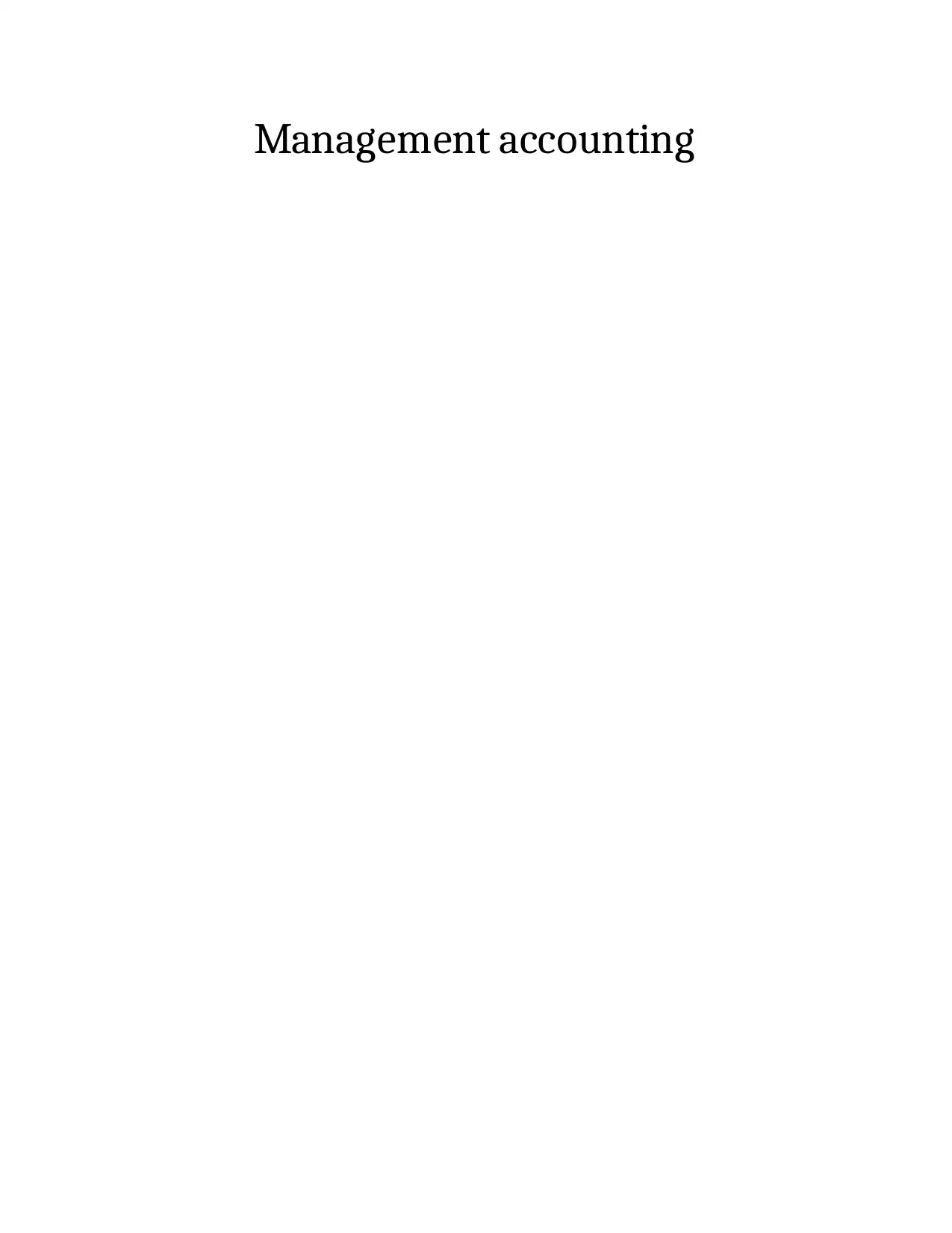
Management accounting
Secure Best Marks with AI Grader
Need help grading? Try our AI Grader for instant feedback on your assignments.
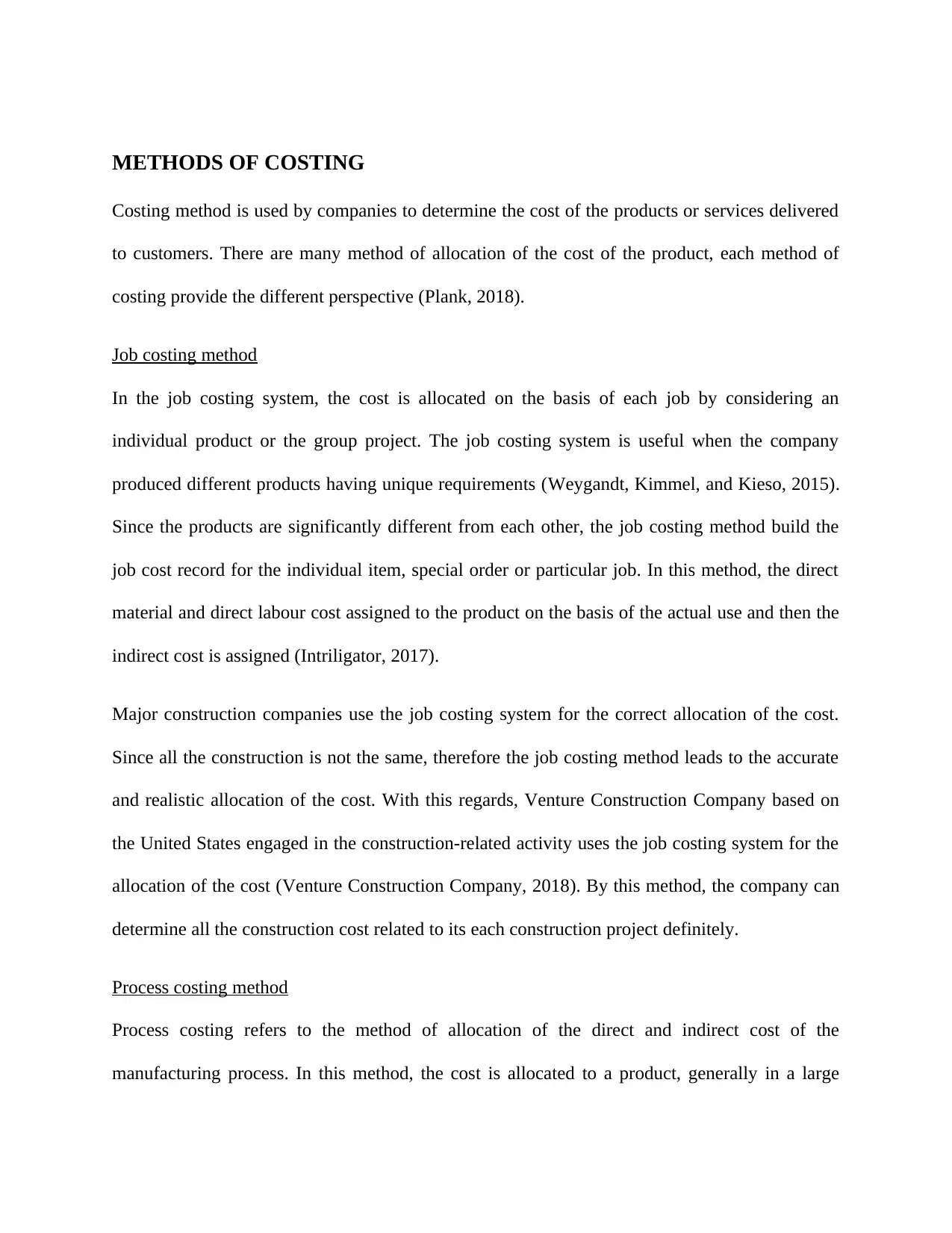
METHODS OF COSTING
Costing method is used by companies to determine the cost of the products or services delivered
to customers. There are many method of allocation of the cost of the product, each method of
costing provide the different perspective (Plank, 2018).
Job costing method
In the job costing system, the cost is allocated on the basis of each job by considering an
individual product or the group project. The job costing system is useful when the company
produced different products having unique requirements (Weygandt, Kimmel, and Kieso, 2015).
Since the products are significantly different from each other, the job costing method build the
job cost record for the individual item, special order or particular job. In this method, the direct
material and direct labour cost assigned to the product on the basis of the actual use and then the
indirect cost is assigned (Intriligator, 2017).
Major construction companies use the job costing system for the correct allocation of the cost.
Since all the construction is not the same, therefore the job costing method leads to the accurate
and realistic allocation of the cost. With this regards, Venture Construction Company based on
the United States engaged in the construction-related activity uses the job costing system for the
allocation of the cost (Venture Construction Company, 2018). By this method, the company can
determine all the construction cost related to its each construction project definitely.
Process costing method
Process costing refers to the method of allocation of the direct and indirect cost of the
manufacturing process. In this method, the cost is allocated to a product, generally in a large
Costing method is used by companies to determine the cost of the products or services delivered
to customers. There are many method of allocation of the cost of the product, each method of
costing provide the different perspective (Plank, 2018).
Job costing method
In the job costing system, the cost is allocated on the basis of each job by considering an
individual product or the group project. The job costing system is useful when the company
produced different products having unique requirements (Weygandt, Kimmel, and Kieso, 2015).
Since the products are significantly different from each other, the job costing method build the
job cost record for the individual item, special order or particular job. In this method, the direct
material and direct labour cost assigned to the product on the basis of the actual use and then the
indirect cost is assigned (Intriligator, 2017).
Major construction companies use the job costing system for the correct allocation of the cost.
Since all the construction is not the same, therefore the job costing method leads to the accurate
and realistic allocation of the cost. With this regards, Venture Construction Company based on
the United States engaged in the construction-related activity uses the job costing system for the
allocation of the cost (Venture Construction Company, 2018). By this method, the company can
determine all the construction cost related to its each construction project definitely.
Process costing method
Process costing refers to the method of allocation of the direct and indirect cost of the
manufacturing process. In this method, the cost is allocated to a product, generally in a large
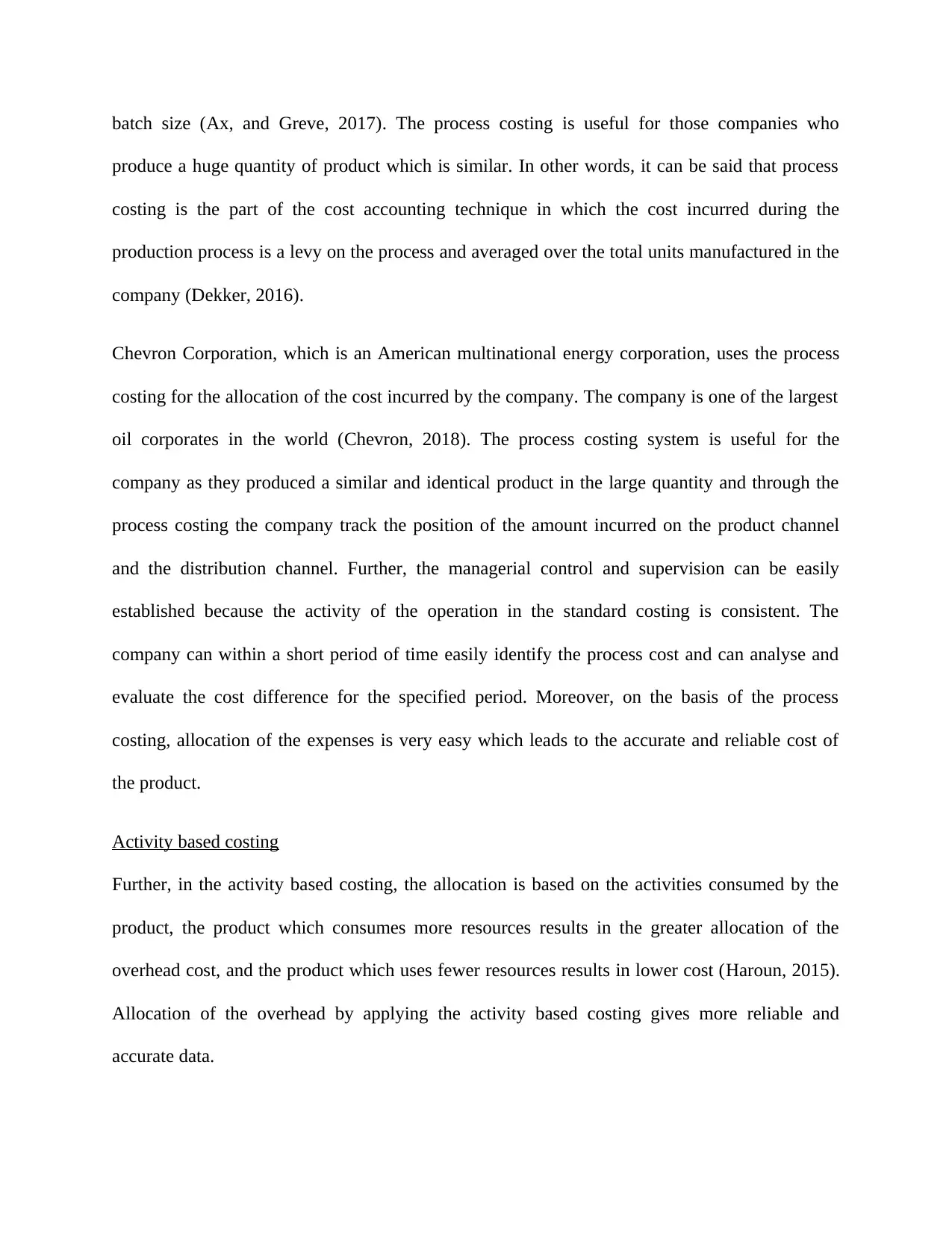
batch size (Ax, and Greve, 2017). The process costing is useful for those companies who
produce a huge quantity of product which is similar. In other words, it can be said that process
costing is the part of the cost accounting technique in which the cost incurred during the
production process is a levy on the process and averaged over the total units manufactured in the
company (Dekker, 2016).
Chevron Corporation, which is an American multinational energy corporation, uses the process
costing for the allocation of the cost incurred by the company. The company is one of the largest
oil corporates in the world (Chevron, 2018). The process costing system is useful for the
company as they produced a similar and identical product in the large quantity and through the
process costing the company track the position of the amount incurred on the product channel
and the distribution channel. Further, the managerial control and supervision can be easily
established because the activity of the operation in the standard costing is consistent. The
company can within a short period of time easily identify the process cost and can analyse and
evaluate the cost difference for the specified period. Moreover, on the basis of the process
costing, allocation of the expenses is very easy which leads to the accurate and reliable cost of
the product.
Activity based costing
Further, in the activity based costing, the allocation is based on the activities consumed by the
product, the product which consumes more resources results in the greater allocation of the
overhead cost, and the product which uses fewer resources results in lower cost (Haroun, 2015).
Allocation of the overhead by applying the activity based costing gives more reliable and
accurate data.
produce a huge quantity of product which is similar. In other words, it can be said that process
costing is the part of the cost accounting technique in which the cost incurred during the
production process is a levy on the process and averaged over the total units manufactured in the
company (Dekker, 2016).
Chevron Corporation, which is an American multinational energy corporation, uses the process
costing for the allocation of the cost incurred by the company. The company is one of the largest
oil corporates in the world (Chevron, 2018). The process costing system is useful for the
company as they produced a similar and identical product in the large quantity and through the
process costing the company track the position of the amount incurred on the product channel
and the distribution channel. Further, the managerial control and supervision can be easily
established because the activity of the operation in the standard costing is consistent. The
company can within a short period of time easily identify the process cost and can analyse and
evaluate the cost difference for the specified period. Moreover, on the basis of the process
costing, allocation of the expenses is very easy which leads to the accurate and reliable cost of
the product.
Activity based costing
Further, in the activity based costing, the allocation is based on the activities consumed by the
product, the product which consumes more resources results in the greater allocation of the
overhead cost, and the product which uses fewer resources results in lower cost (Haroun, 2015).
Allocation of the overhead by applying the activity based costing gives more reliable and
accurate data.
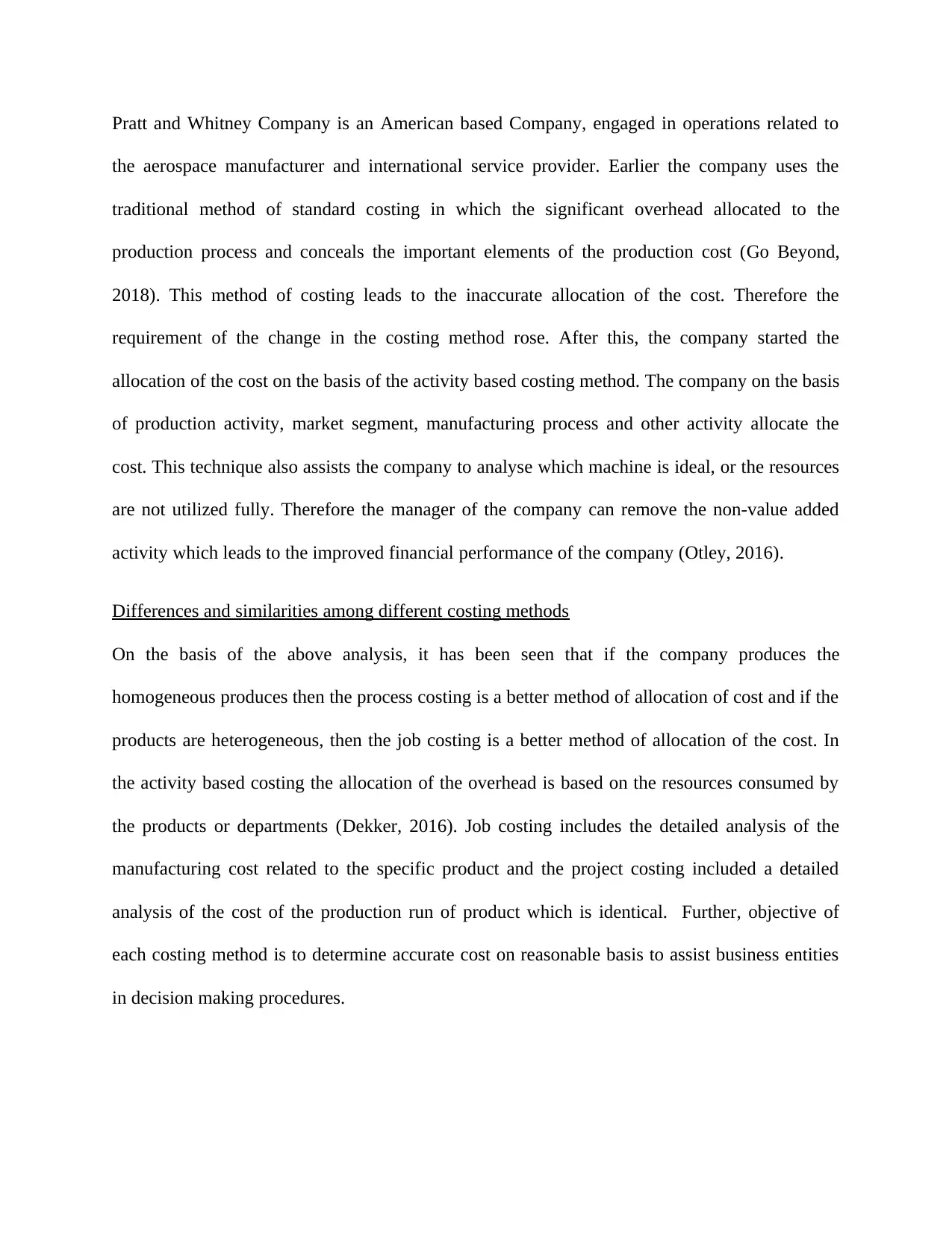
Pratt and Whitney Company is an American based Company, engaged in operations related to
the aerospace manufacturer and international service provider. Earlier the company uses the
traditional method of standard costing in which the significant overhead allocated to the
production process and conceals the important elements of the production cost (Go Beyond,
2018). This method of costing leads to the inaccurate allocation of the cost. Therefore the
requirement of the change in the costing method rose. After this, the company started the
allocation of the cost on the basis of the activity based costing method. The company on the basis
of production activity, market segment, manufacturing process and other activity allocate the
cost. This technique also assists the company to analyse which machine is ideal, or the resources
are not utilized fully. Therefore the manager of the company can remove the non-value added
activity which leads to the improved financial performance of the company (Otley, 2016).
Differences and similarities among different costing methods
On the basis of the above analysis, it has been seen that if the company produces the
homogeneous produces then the process costing is a better method of allocation of cost and if the
products are heterogeneous, then the job costing is a better method of allocation of the cost. In
the activity based costing the allocation of the overhead is based on the resources consumed by
the products or departments (Dekker, 2016). Job costing includes the detailed analysis of the
manufacturing cost related to the specific product and the project costing included a detailed
analysis of the cost of the production run of product which is identical. Further, objective of
each costing method is to determine accurate cost on reasonable basis to assist business entities
in decision making procedures.
the aerospace manufacturer and international service provider. Earlier the company uses the
traditional method of standard costing in which the significant overhead allocated to the
production process and conceals the important elements of the production cost (Go Beyond,
2018). This method of costing leads to the inaccurate allocation of the cost. Therefore the
requirement of the change in the costing method rose. After this, the company started the
allocation of the cost on the basis of the activity based costing method. The company on the basis
of production activity, market segment, manufacturing process and other activity allocate the
cost. This technique also assists the company to analyse which machine is ideal, or the resources
are not utilized fully. Therefore the manager of the company can remove the non-value added
activity which leads to the improved financial performance of the company (Otley, 2016).
Differences and similarities among different costing methods
On the basis of the above analysis, it has been seen that if the company produces the
homogeneous produces then the process costing is a better method of allocation of cost and if the
products are heterogeneous, then the job costing is a better method of allocation of the cost. In
the activity based costing the allocation of the overhead is based on the resources consumed by
the products or departments (Dekker, 2016). Job costing includes the detailed analysis of the
manufacturing cost related to the specific product and the project costing included a detailed
analysis of the cost of the production run of product which is identical. Further, objective of
each costing method is to determine accurate cost on reasonable basis to assist business entities
in decision making procedures.
Secure Best Marks with AI Grader
Need help grading? Try our AI Grader for instant feedback on your assignments.
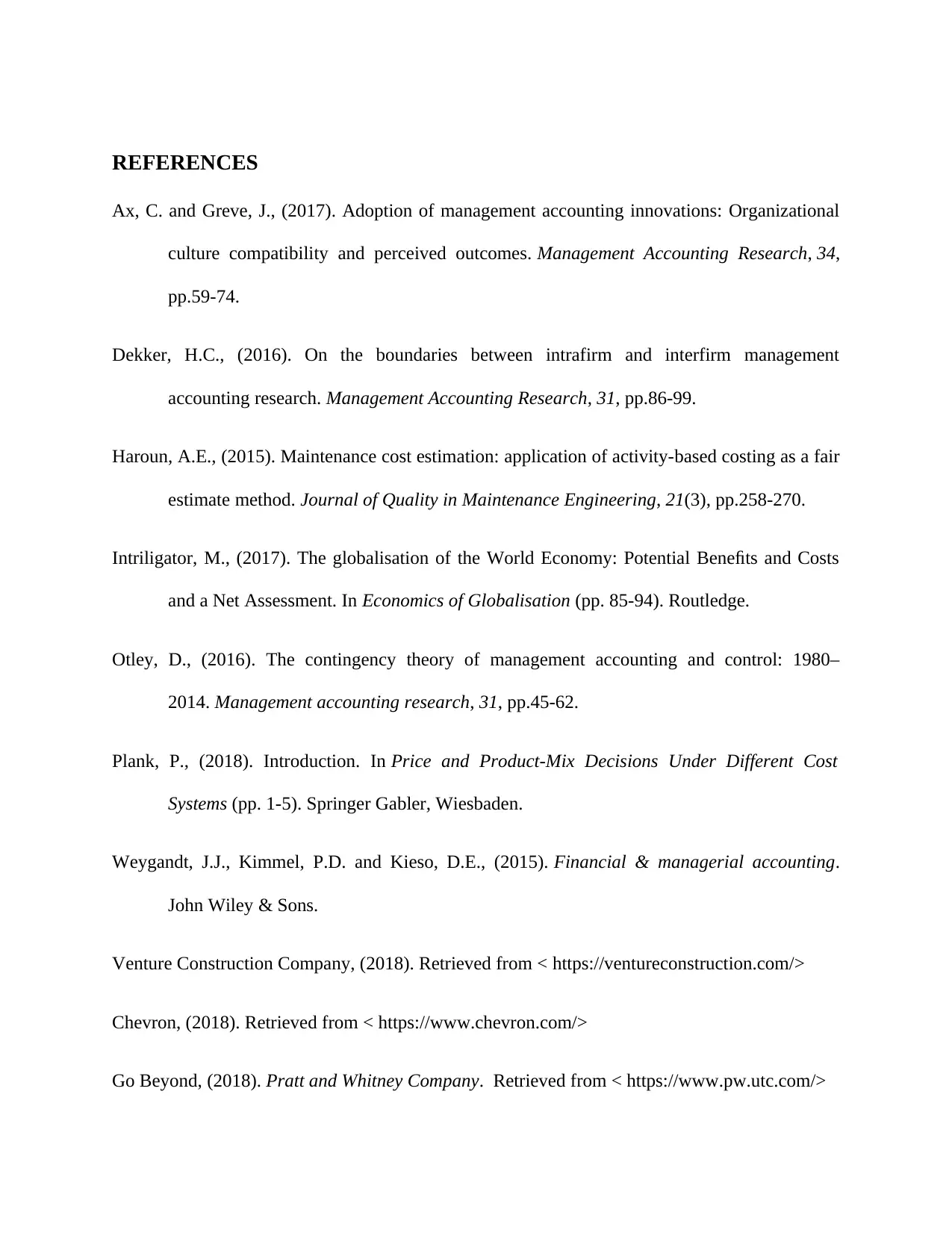
REFERENCES
Ax, C. and Greve, J., (2017). Adoption of management accounting innovations: Organizational
culture compatibility and perceived outcomes. Management Accounting Research, 34,
pp.59-74.
Dekker, H.C., (2016). On the boundaries between intrafirm and interfirm management
accounting research. Management Accounting Research, 31, pp.86-99.
Haroun, A.E., (2015). Maintenance cost estimation: application of activity-based costing as a fair
estimate method. Journal of Quality in Maintenance Engineering, 21(3), pp.258-270.
Intriligator, M., (2017). The globalisation of the World Economy: Potential Benefits and Costs
and a Net Assessment. In Economics of Globalisation (pp. 85-94). Routledge.
Otley, D., (2016). The contingency theory of management accounting and control: 1980–
2014. Management accounting research, 31, pp.45-62.
Plank, P., (2018). Introduction. In Price and Product-Mix Decisions Under Different Cost
Systems (pp. 1-5). Springer Gabler, Wiesbaden.
Weygandt, J.J., Kimmel, P.D. and Kieso, D.E., (2015). Financial & managerial accounting.
John Wiley & Sons.
Venture Construction Company, (2018). Retrieved from < https://ventureconstruction.com/>
Chevron, (2018). Retrieved from < https://www.chevron.com/>
Go Beyond, (2018). Pratt and Whitney Company. Retrieved from < https://www.pw.utc.com/>
Ax, C. and Greve, J., (2017). Adoption of management accounting innovations: Organizational
culture compatibility and perceived outcomes. Management Accounting Research, 34,
pp.59-74.
Dekker, H.C., (2016). On the boundaries between intrafirm and interfirm management
accounting research. Management Accounting Research, 31, pp.86-99.
Haroun, A.E., (2015). Maintenance cost estimation: application of activity-based costing as a fair
estimate method. Journal of Quality in Maintenance Engineering, 21(3), pp.258-270.
Intriligator, M., (2017). The globalisation of the World Economy: Potential Benefits and Costs
and a Net Assessment. In Economics of Globalisation (pp. 85-94). Routledge.
Otley, D., (2016). The contingency theory of management accounting and control: 1980–
2014. Management accounting research, 31, pp.45-62.
Plank, P., (2018). Introduction. In Price and Product-Mix Decisions Under Different Cost
Systems (pp. 1-5). Springer Gabler, Wiesbaden.
Weygandt, J.J., Kimmel, P.D. and Kieso, D.E., (2015). Financial & managerial accounting.
John Wiley & Sons.
Venture Construction Company, (2018). Retrieved from < https://ventureconstruction.com/>
Chevron, (2018). Retrieved from < https://www.chevron.com/>
Go Beyond, (2018). Pratt and Whitney Company. Retrieved from < https://www.pw.utc.com/>

1 out of 6
Related Documents
Your All-in-One AI-Powered Toolkit for Academic Success.
+13062052269
info@desklib.com
Available 24*7 on WhatsApp / Email
![[object Object]](/_next/static/media/star-bottom.7253800d.svg)
Unlock your academic potential
© 2024 | Zucol Services PVT LTD | All rights reserved.





